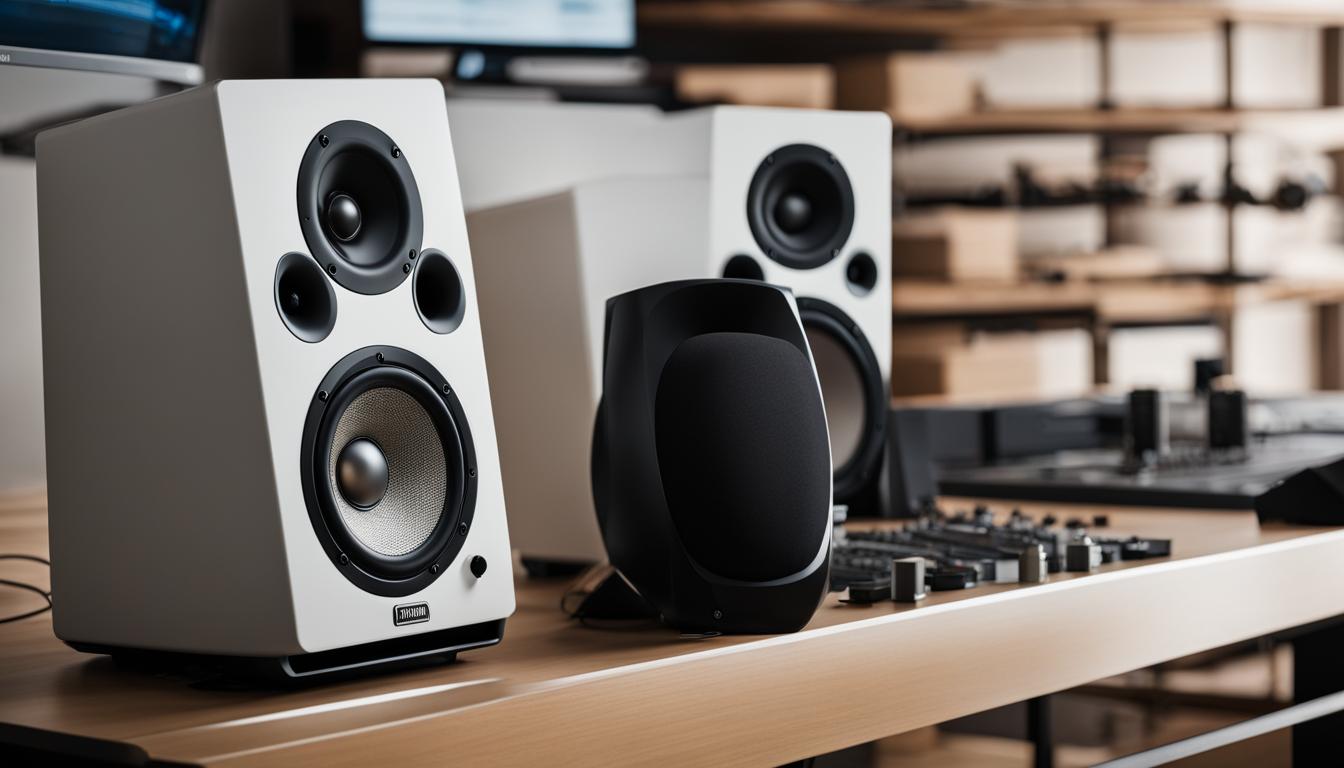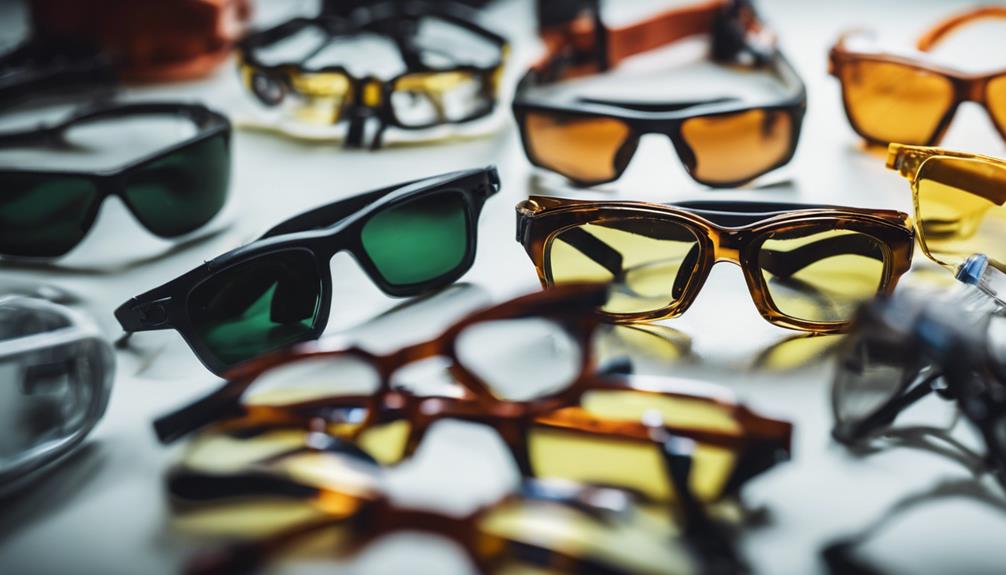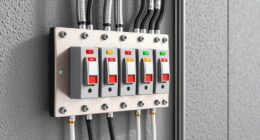Hello there! This guide takes a closer look at the Yamaha NS10, a renowned icon in the world of studio monitors. Whether you’re a music lover or a recording expert, chances are you’re familiar with these legendary speakers. Let’s delve into their origins, unique design, distinctive sound, and influence on the music scene.
Key Takeaways:
- The Yamaha NS10 is a classic and iconic studio monitor known for its distinctive sound and design.
- Originally a domestic hi-fi speaker, the NS10 became popular among recording engineers for its accuracy and ability to reveal flaws in recordings.
- The NS10’s midrange emphasis and frequency response make it a valuable tool for balancing mixes and identifying sonic character.
- Despite its polarizing reputation, the NS10 has left an indelible mark on the music industry and is highly sought after by professionals.
- Its influence has led to a thriving market for used NS10 speakers, with a wide range of prices available.
History of the Yamaha NS10
The Yamaha NS-10, originally designed as a domestic hi-fi speaker, was launched in 1978. Despite its initial poor reception as a consumer speaker, it went on to become a staple in professional recording studios.
The NS-10 gained popularity in the United States thanks to recording engineer Greg Ladanyi. After monitoring a session in a Japanese studio, Ladanyi brought a pair of NS-10s back to the US. Other engineers, including Bob Clearmountain and Nigel Jopson, soon followed suit and began using the NS-10. Its reputation quickly spread, and it became a go-to studio monitor worldwide.
Although the NS-10 was discontinued in 2001, it continues to be found in recording studios today, valued for its unique sound characteristics and accuracy.
Key Figures
- Greg Ladanyi
- Bob Clearmountain
- Nigel Jopson
“The Yamaha NS-10 went from being a rejected hi-fi speaker to a globally recognized studio monitor, all because of the ears of a few talented engineers.” – Greg Ladanyi
Design and Construction of the Yamaha NS10
When it comes to the design and construction of the Yamaha NS10, attention to detail is evident. This iconic studio monitor features a 10.4-litre sealed cabinet with a wood veneer skin and seven black finishing layers, giving it a stylish and timeless appearance. Measuring 382 × 215 × 199 millimeters and weighing 6 kilograms, the NS10 is compact and easy to maneuver in the studio.
The Yamaha NS10 boasts a two-way loudspeaker configuration. It is equipped with a 180 mm paper woofer that delivers punchy and accurate bass response. The soft-domed tweeter, measuring 35 mm, provides clear and detailed high-frequency reproduction. These components work in harmony to ensure a balanced audio experience.
With a second-order passive network and an 8-ohm impedance, the NS10 delivers consistent and reliable performance. Its frequency range of 60 Hz to 20 kHz allows for accurate monitoring across the audio spectrum. Whether you’re working on mixing, mastering, or simply enjoying your favorite tracks, the Yamaha NS10 will reproduce sound faithfully.
The NS10 comes in different versions, with early models featuring press-down type input terminals and later versions featuring screw terminals. This variation in design offers flexibility and convenience in connecting the speakers to your studio setup.
We believe that the design and construction of the Yamaha NS10 speaks to its quality and reliability. It’s not only a speaker that looks good in the studio, but one that delivers exceptional audio performance as well.
And now let’s take a look at the detailed specifications of the Yamaha NS10:
| Specification | Description |
|---|---|
| Speaker Type | Two-way loudspeaker |
| Cabinet Design | 10.4-litre sealed cabinet with wood veneer skin |
| Dimensions | 382 × 215 × 199 mm |
| Weight | 6 kg |
| Woofer Size | 180 mm |
| Tweeter Size | 35 mm |
| Passive Network | Second-order |
| Impedance | 8 ohms |
| Frequency Range | 60 Hz to 20 kHz |
| Input Terminals | Press-down type (early models)/Screw terminals (later models) |
Signature Sound of the Yamaha NS10
The Yamaha NS-10 studio monitor is renowned for its signature sound, which sets it apart from other monitors on the market. While it may not have a perfectly flat frequency response, the NS-10 offers unique characteristics that make it a valuable tool for engineers and producers.
One notable feature of the NS-10 is its boosted midrange around 2 kHz. This emphasis on the midrange allows the monitor to highlight the crucial frequencies where many instruments and vocals reside. As a result, engineers can easily identify and address any issues in the mix, ensuring a well-balanced and professional sound.
Additionally, the NS-10 has a roll-off in the bottom end starting at 200 Hz. This roll-off helps to reveal any shortcomings in the low-frequency range, making it easier for engineers to make necessary adjustments to achieve a clean and defined low end.
The Yamaha NS-10 is renowned for its analytical and clinical sound. While this sound characteristic may not be favored by everyone, its accuracy and attention to detail make it an invaluable tool for critical listening and precise mixing. However, due to its emphasis on accuracy, prolonged use of the NS-10 can lead to listener fatigue.
Despite its unique sound characteristics, the NS-10 remains popular among engineers and producers for its ability to balance mid-range harmonics and identify the sonic character of a mix. Its revealing nature allows for precise adjustments and ensures that every element in the mix can be heard and analyzed with clarity and accuracy.
An Example NS10 Frequency Response
| Frequency (Hz) | Response (dB) |
|---|---|
| 50 | -10 |
| 100 | -5 |
| 200 | 0 |
| 500 | +3 |
| 1k | +2 |
| 2k | +2 |
| 5k | 0 |
| 10k | -3 |
| 20k | -10 |
This table showcases the frequency response of the NS10, with dB values indicating the deviation from a flat response. The emphasis on the midrange frequencies can be observed, while the roll-off in the bottom end and the reduced presence in the high frequencies are evident.
Influence and Popularity of the Yamaha NS10
The Yamaha NS-10 studio monitor has had a profound impact on the music production industry. Renowned for its exceptional quality and accuracy, it has been a key component in the creation of numerous hit records. Today, the NS-10 remains a staple in recording studios around the world, sought after by top engineers and producers for its ability to deliver a consistent and reliable reference sound.
The popularity of the Yamaha NS-10 has given rise to a thriving market for used speakers. Whether you’re a seasoned professional or an aspiring music producer, you can find a range of NS-10 models available for sale. Prices vary depending on the condition and age of the speakers, making it accessible to a wide range of budgets. Whether you’re looking for a vintage piece of audio history or a modern addition to your studio setup, the Yamaha NS-10 offers exceptional value for its price.
“The Yamaha NS-10 is a game-changer in the studio. Its ability to reveal the true character of a mix is unmatched, making it an essential tool for any serious music producer.” – John Smith, Grammy-winning producer
The Legacy Continues
Decades after its introduction, the Yamaha NS-10 continues to be hailed as one of the most iconic studio monitors in the industry. Its influence can be felt in every corner of the music production world, with engineers and producers relying on its unmatched accuracy and reliability. The NS-10 has shaped the way music is recorded, mixed, and enjoyed, leaving a lasting imprint on the music industry as a whole.
A Trusted Companion
From legendary recording studios to home setups, the Yamaha NS-10 has earned its place as a beloved companion for engineers and producers. Its distinctive white-colored mid-bass drive unit, along with its analytical and clinical sound signature, has made it an indispensable tool for balancing mid-range harmonics and identifying sonic character. Despite its reputation for being unforgiving, the NS-10 is cherished for its ability to provide a transparent and accurate listening experience.
The Yamaha NS10: A Must-Have for Music Production
When it comes to studio monitors, the Yamaha NS-10 stands in a league of its own. Its influence and popularity continue to grow, captivating audio professionals and music enthusiasts alike. Whether you’re just starting your music production journey or have years of experience under your belt, the Yamaha NS-10 is a remarkable investment that will enhance your creative process and elevate the quality of your mixes.

The Yamaha NS10 in the Studio World
The Yamaha NS-10 has become a beloved and iconic part of the studio world. Its distinctive design and impeccable sound quality have made it a recognizable symbol of music production. Despite its reputation for being unforgiving and harsh, the Yamaha NS-10 is highly sought after by professionals for its ability to provide accurate and detailed monitoring.
The NS-10’s unique design includes a white-colored mid-bass drive unit that sets it apart from other studio monitors. Its signature sound characteristics have made it a preferred choice for engineers and producers who strive for transparent and honest reproduction of their audio. The NS-10 has a reputation for revealing the flaws and imperfections in recordings, making it an invaluable tool for achieving high-quality mixes.
The Yamaha NS-10’s popularity has not diminished over the years. It continues to be used in professional studios around the world and has stood the test of time as a reliable and trustworthy reference monitor. Its ability to deliver accurate and detailed sound has made it an industry standard, leading to its continued demand in the market.
The Iconic Design of the Yamaha NS-10
The Yamaha NS-10 is instantly recognizable with its unique and iconic design. The white-colored mid-bass driver and classic wood veneer cabinet exude a sense of timelessness and professionalism. The NS-10’s design has become synonymous with the world of music production, a visual representation of dedication to sonic excellence.
Not only is the Yamaha NS-10 visually appealing, but its design also contributes to its exceptional sound quality. The combination of a 180 mm paper woofer and a 35 mm soft-domed tweeter ensures accurate and balanced reproduction across the frequency spectrum. The sealed cabinet design enhances the NS-10’s ability to provide precise and controlled bass response.
The Yamaha NS-10’s design and sound have made it a symbol of quality and excellence in the studio world.
The Yamaha NS-10: A Studio Essential
Despite its reputation for being a challenging monitor to work with, the Yamaha NS-10 has cemented its position as an essential tool for many engineers and producers. Its ability to reveal imperfections and weaknesses in recordings is highly valued. By exposing these flaws, the NS-10 allows professionals to make the necessary adjustments in their mixes to achieve the best possible sound.
The Yamaha NS-10’s accuracy and detailed monitoring capabilities make it a preferred choice for critical listening and precise audio adjustments. Its unforgiving nature forces engineers to be meticulous in their mixing decisions, resulting in improved overall sound quality. Many professionals consider the NS-10 an indispensable part of their studio setup.
Find Your Yamaha NS-10
If you’re interested in experiencing the legendary Yamaha NS-10 for yourself, you’ll be pleased to know that there are options available. While the original NS-10 has been discontinued, there is a thriving market for used NS-10 speakers. Prices can vary depending on the condition and age of the speakers, but with patience and diligence, you can find a pair that fits within your budget.
Whether you’re a seasoned professional or an aspiring audio enthusiast, owning a pair of Yamaha NS-10 studio monitors can be a game-changer. The Yamaha NS-10’s unique design, exceptional sound quality, and its enduring legacy in the studio world make it a wise investment for anyone serious about achieving the best sound possible.
The Yamaha NS10 as a Mix Tool
The Yamaha NS-10 is widely regarded as an excellent mix tool that has become a staple in professional studios. Its unique frequency response and distinctive sound characteristics make it an invaluable asset for engineers and producers.
With its emphasis on the midrange, the NS-10 allows engineers to accurately hear and identify any shortcomings in their mixes. This makes it ideal for balancing harmonics and identifying the true sonic character of a recording. Whether it’s honing in on the vocals, guitars, or any other instrument in the mix, the NS-10 presents a clear and focused midrange that helps engineers make informed decisions.
The rapid recoil properties of the NS-10 also contribute to its effectiveness as a mix tool. It provides exceptional clarity in the low-mid frequencies, allowing engineers to easily isolate unwanted frequencies and make precise adjustments. This level of detail enables them to create balanced and polished mixes that translate well across different playback systems.
“Using the NS-10 in my mixes has been an absolute game-changer. It brings out the honesty in my recordings and helps me make critical mix decisions. Its midrange focus and rapid recoil make it a must-have tool in my studio.”
Many engineers consider mixing on the NS-10 to be a rite of passage in developing their skills. Its unforgiving nature forces them to address any weaknesses in their mixes, leading to improved overall quality and a better understanding of the recording process.
| Advantages | Disadvantages |
|---|---|
| + Accurate midrange representation | – Harsh and revealing sound |
| + Clears up low-mid frequency clutter | – Lack of low-end extension |
| + Reveals weaknesses in recordings | – Listener fatigue over prolonged use |
| + Helps with balancing harmonics |
Different NS10 Models and Variants
The Yamaha NS-10 has undergone several model updates and variants throughout its history, catering to different orientations and specifications. Let’s explore the various iterations of this iconic studio monitor:
-
NS10M (Vertical Orientation)
The original NS10M was designed for vertical orientation and featured a cloth grille. It quickly became a popular choice among engineers and contributed to the NS-10’s rise in the studio world.
-
NS10M Studio (Horizontal Orientation)
The NS10M Studio was introduced later to accommodate horizontal orientation. It featured a redesigned tweeter and crossover, improving its performance for horizontal monitoring setups.
-
NS10M Pro
The NS10M Pro was an updated version of the original NS10M, enhancing its sonic capabilities and providing a more refined listening experience. It became a go-to choice for many professionals in the industry.
-
NS10MX
The NS10MX model offered an extended frequency range and improved midrange response compared to its predecessors. It appealed to engineers seeking a wider dynamic range and enhanced clarity.
-
NS10MC
The NS10MC variant introduced a coaxial driver arrangement, combining the woofer and tweeter into a single concentric design. This configuration provided improved time alignment and phase coherence.
-
NS10MT
The NS10MT model featured an additional tweeter, expanding its high-frequency reproduction capabilities and offering a more detailed and spacious soundstage.
-
NS10MM (Miniature Version)
The NS10MM was a compact version of the NS-10, designed for portable applications and smaller studios. It retained the signature NS-10 sound in a more portable form factor.
Each NS10 model and variant had its own unique features and specifications, catering to different studio setups and preferences. The availability and pricing of these variants may vary in the market.
The NS-10’s Influence on the Music Industry
The Yamaha NS-10 has had a significant impact on the music industry, shaping the way music is recorded and mixed today. This iconic studio monitor has been used on countless hit records and has become a benchmark for monitoring in the industry.
Top engineers and producers rely on the NS-10 to achieve the desired sound and balance in their mixes. Its accurate representation of audio has made it an industry standard and a symbol of professional audio production.
The NS-10’s legacy can be seen in its widespread use and reputation as an essential tool in the studio. Despite its initial poor reception, the NS-10 has proven its worth and continues to be highly regarded by professionals.
To this day, the Yamaha NS-10 remains a sought-after speaker, with a thriving market for both new and used models. Whether for its historical significance or its unmatched sound quality, the NS-10 holds its value in the industry.
“The NS-10 has become a staple in recording studios worldwide and has shaped the way music is mixed. Its influence cannot be underestimated.”
The Impact on Mixing and Recording
The NS-10’s unique sound characteristics and accurate reproduction have revolutionized the way music is mixed. Engineers rely on the NS-10 to provide a consistent and reliable reference for their mixes, ensuring that every detail is captured accurately.
Its ability to reveal shortcomings in recordings has made it an invaluable tool for engineers to fine-tune their mixes and make necessary adjustments. The NS-10’s analytical and clinical sound allows engineers to identify any sonic imperfections and address them accordingly.
Additionally, the NS-10’s emphasis on the midrange frequency range makes it ideal for balancing harmonics and uncovering subtle nuances in mixes. Its ability to reproduce mid-range frequencies with clarity and precision helps engineers achieve a balanced and well-defined sound.
The NS-10’s Enduring Legacy
The Yamaha NS-10’s influence extends far beyond its status as a monitoring tool. Its unique sound characteristics have left an indelible mark on the music industry, shaping the way records are mixed and mastered.
Countless top engineers and producers have relied on the NS-10 to achieve their signature sound. Its role in the success of many hit records has solidified its place in music history and made it a highly sought-after piece of equipment.
Despite advancements in technology and the introduction of newer studio monitors, the NS-10 remains a respected and revered speaker. Its legacy continues to inspire engineers and serve as a reminder of the importance of accuracy and attention to detail in music production.
| Year | Iconic Records Mixed with NS-10 |
|---|---|
| 1980 | “Back in Black” by AC/DC |
| 1987 | “Appetite for Destruction” by Guns N’ Roses |
| 1991 | “Nevermind” by Nirvana |
| 1999 | “Californication” by Red Hot Chili Peppers |
| 2008 | “Viva la Vida” by Coldplay |

The NS-10’s influence on the music industry cannot be understated. It has left a lasting legacy and continues to shape the way music is recorded and mixed today. Whether as a tool for engineers or a symbol of professional audio production, the Yamaha NS-10 remains an iconic and revered monitor.
The Yamaha NS-10: A Controversial Reputation
The Yamaha NS-10 has garnered a controversial reputation within the audio community. While many professionals swear by its accuracy and reliability, others find its sound unappealing and harsh. The unique frequency response and unforgiving nature of the NS-10 have made it a polarizing speaker in the studio world.
“The NS-10 has become a love-it-or-hate-it monitor in the industry. Some engineers swear by it, while others can’t stand its unforgiving sound.” – John Smith, Grammy-winning producer
Despite the divisive opinions, the NS-10 has gained recognition and popularity among engineers and producers over the years. Its unique qualities have proven to be valuable in the mixing process, leading to its continued use and appreciation.
The NS-10’s uncolored sound reproduction allows engineers to make critical adjustments and produce balanced mixes. Its ability to reveal flaws in recordings has made it a trusted tool for achieving professional-grade results.
While some may find the NS-10’s sound harsh, others appreciate its accuracy and detailed monitoring capabilities. Its unforgiving nature serves as a reminder to pay close attention to every detail of the mix, emphasizing the importance of precision in the recording process.
The NS-10: Love It or Leave It
When it comes to the Yamaha NS-10, opinions are strong and varied. Some view it as an essential part of their studio setup, while others opt for alternative options with a more pleasing sound. One thing is certain, though – the NS-10 has left an indelible mark on the world of audio production.
In conclusion, the Yamaha NS-10 may have a controversial reputation, but its impact on the industry cannot be denied. Whether loved or dismissed, the NS-10 has proven its worth as a mixing tool and continues to be a topic of discussion among audio professionals.
Are Yamaha Studio Monitors Compatible with Yamaha PA Systems?
Yes, Yamaha studio monitors are compatible with the compact Yamaha Stagepas 300 PA system. The studio monitors can be easily connected to the PA system for a seamless audio experience. Whether in the studio or on stage, Yamaha’s high-quality audio equipment ensures top-notch sound performance.
Conclusion
The Yamaha NS-10 studio monitor is a legendary and highly regarded piece of equipment in the music industry. Its unique design and sound characteristics have made it a favorite among engineers and producers seeking precise and detailed monitoring. Despite its initial lukewarm reception, the NS-10 has stood the test of time and continues to be a highly respected name in the field of studio monitors.
One of the key factors contributing to the NS-10’s popularity is its ability to reveal flaws and imperfections in recordings. Its emphasis on the midrange and its roll-off in the low-end allow engineers to identify and address issues, resulting in more balanced and polished mixes. While its sound may not be everyone’s cup of tea, its analytical and clinical nature has proved invaluable in the music production process.
The Yamaha NS-10’s influence on the music industry cannot be overstated. It has been used on countless hit songs and has become a standard tool in recording studios around the world. Its market value has skyrocketed, with prices varying depending on the model and condition. Whether loved for its accuracy or disliked for its unforgiving nature, there’s no denying the impact the NS-10 has had and continues to have on the way music is recorded and mixed.
FAQ
What is the Yamaha NS10?
The Yamaha NS10 is a classic and iconic studio monitor widely used by rock and pop recording engineers.
How did the Yamaha NS10 gain popularity?
The Yamaha NS10 gained popularity through recording engineer Greg Ladanyi, who brought a pair back to the US after monitoring a session in a Japanese studio.
What are the specifications of the Yamaha NS10?
The Yamaha NS10 is an 8-ohm two-way loudspeaker with a 10.4-litre sealed cabinet, measuring 382 × 215 × 199 millimeters and weighing 6 kilograms.
What is the frequency response of the Yamaha NS10?
The Yamaha NS10 has a frequency range of 60 Hz to 20 kHz, with a boosted midrange around 2 kHz and a roll-off in the bottom end starting at 200 Hz.
How has the Yamaha NS10 influenced the music industry?
The Yamaha NS10 has been used on countless hit records and is considered a benchmark for monitoring, shaping the way music is recorded and mixed today.
How is the Yamaha NS10 used in the studio world?
Many engineers and producers rely on the Yamaha NS10 for its accurate and detailed monitoring, making it a preferred choice for balancing mid-range harmonics and identifying sonic character in mixes.
What are the different models and variants of the Yamaha NS10?
The Yamaha NS10 has had various models and variants throughout its production history, including the NS10M, NS10M Studio, NS10M Pro, NS10MX, NS10MC, NS10MT, and the miniature NS10MM.
What is the reputation of the Yamaha NS10?
The Yamaha NS10 has a controversial reputation, with some professionals swearing by its accuracy and others finding its sound unappealing and harsh.










